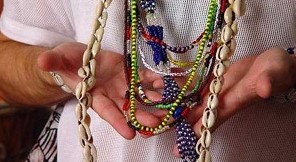All About Santeria Necklaces: Learn How to Clean Them, the Ceremony of Giving, How to Wear Them, What NOT to Do with the Necklaces, and MUCH MORE.
Surely, you’ve seen a Santera wearing necklaces and bracelets of a specific color more than once, never taking them off and always wearing them. It’s only natural that your curiosity will be piqued, as many Santeros wear them.
This is because they have a purpose and are closely tied to everything the cult represents. If you want to learn more about this, continue reading this article.
What is the meaning of Santeria necklaces?
The use of these necklaces comes from the religion practiced in Africa that was brought to Cuba. They are called elekes and are worn by the faithful who practice this cult because they are elements of protection, power, and guidance according to the Orisha for whom they are designated.
These have a meaning of initiation into the cult or baptism in this religion and symbolize respect, faith, belonging, and devotion. Therefore, they cannot be used for fashion or taste.
How to wear necklaces?
As you can see, I’m not talking about any accessory you can buy in a store and wear whenever you want; it’s something that goes much further and has implications and ways to wear them. If you’re not familiar with them, I’ll show you here:
- You must wear them around your neck, unless there is a special case.
- They must be stored properly and not in your pockets, purse, or bag.
- If you’re going to change clothes, you must remove the necklace first.
- When visiting hospitals, cemeteries, or prisons, you must remove it.
- When it’s time to store it, you should do so in a white handkerchief, leaving it taut so the beads don’t get tangled, and you should stay away from people.
- If you are a woman, you must wear the necklace over your clothing.
- If you are a man, you must wear the necklace underneath or tucked into your clothing.
How to clean necklaces?
When we talk about cleansing in Santeria, it doesn’t specifically refer to cleaning the exterior, but rather to eliminating all the bad energies that accumulate in the object. If you don’t know how to do it, here are the steps you need to follow:
- Wash the necklaces with a siervo horn.
- Then, wash them with the strong essences. Remember there are seven in total.
- Proceed to wash them with rum, cucuy, and aguardiente.
- Rinse them with the strong essences. Remember there are nine in total.
- Place them on a plate to perform the vigil, submerged in the three drinks, with the three candles in the shape of a triangle, placing the blue one in front, the red one to the left, and the yellow one to the right.
- You must smoke three previously conjured tobaccos, and make a request to the Queen Mother and the three powers to cleanse the necklaces of all bad energies and fill them with positive energies.
What are necklaces for?
After a godfather places the necklace on you through a ceremony, it provides protection against any evil that may affect you.
This is because the Orishas indicate protection and look after the problems you are facing, whether health-related, destiny-related, or threats, among others. This protection lasts forever until the day of your death.
What are the necklaces in Santería?
These types of necklaces can vary greatly depending on the color and the saint they are associated with, so it’s important to have a little knowledge about them. Here are a few:
- Blue beaded necklace: represents the goddess Yemayá and uses beads in various shades of blue.
- (Dark) green beaded necklace: This represents Inlé and uses green, blue, orange, or yellow beads.
- Red and white beaded necklace: This belongs to Shangó and is interspersed with red and white beads.
- Red necklace with black beads: represents Eleggua and signifies life and death. Black and red beads are interspersed, and peonies can be added.
- Yellow bead necklace: This necklace represents the deity Oshun, who symbolizes wealth. Therefore, this necklace is made with yellow beads in different shades. Combinations can be made with Oló Yemú and Ibú Yemú.
- White bead necklace: This represents the Almighty Obatalá and uses transparent beads. It can be Obamoró, Ayáguna, Alaguema, or Aguema.
How are the necklaces presented?

These necklaces can only be presented by consecrated santeros or Ollorishas. They cannot be presented by a Babalawo because they are only responsible for presenting the Orula necklace.
This process lasts one day, but involves two Olorishas, who would be the special godfather or godmother, and an assistant. Taking all this into account, the following is done:
- The Olorishas and the person to whom the necklace will be presented must go to the room in the house where the Santería ceremonies are performed.
- The person to whom the necklace will be presented must kneel on a mat.
- With the help of an agogo, a bell, the necklace is rung and each one is placed on their body.
- After this, secret ceremonies are performed at the end of the individual and head-to-head introduction of the necklaces.
How to receive the necklaces?
We’ve already seen how to give the necklaces, but now it’s important to know what to do when receiving them. For this, there are also a series of steps to follow:
- First, the person must perform ceremonies and rituals throughout the day to prepare themselves mentally, physically, and spiritually.
- The Obá must be present to lead not only the ceremony but also the Oloshas, who are included as witnesses.
- The necklaces are placed one by one on the initiate, and the godfather or godmother must explain the rules they must respect and follow.
- The person is bathed with a ritual of sacred herbs and then must tear the old clothes they are wearing with new scissors.
- After this, they must put on white clothing from head to toe.
- Before concluding, a ceremony known as “Rogation of the Head” is performed to rid the person of bad energies.
- Finally, the necklaces are placed on the person.
What shouldn’t be done with necklaces?
As I mentioned before, necklaces are sacred because they represent a spiritual connection to the deity, and therefore, there are certain things you can’t do while wearing them. Here are some things I’ll mention:
- You shouldn’t wear them if you’re going to have sex.
- You can’t wear them if you’re going to use drugs or alcohol.
- They shouldn’t be kept rolled up or stored away, as this is disrespectful to the deity.
- They can’t be loaned out.
- You shouldn’t undress while wearing the necklace.
- You shouldn’t have fights while wearing it.
- Unless you’re sick, you can’t sleep with the necklaces on.
- You can’t get them wet. This includes bathing with them or going to the beach or river, because they lose their energy.
Why can’t you touch the necklaces?

Normally, many people, upon seeing santero necklaces, are curious and want to touch and hold them, but this is something that should be avoided within the cult.
Necklaces and bracelets should not be touched by others because they can inadvertently leave negative energy and charge imprinted on the necklace, affecting the person wearing it and even causing it to break.
How to make Santería necklaces?
Remember that these types of necklaces cannot be purchased in exotic or any other type of stores. Instead, they are made by the santero himself or by contacting an expert in their making. The way to do it is as follows:
- Rituals, prayers, and chants are performed for consecration.
- A cotton thread is used so that when it is time for refreshing, it can absorb positive energies.
- Depending on the necklace you want to make, you should use the correct colors.
- While making the necklace, the person should say a prayer.
Every religion or cult has objects that carry great meaning and provide significant benefits, such as curing illnesses, warding off bad energies, and even protecting them. Therefore, we must give them the respect they deserve.
